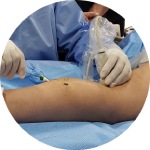
The profunda femoris vein, a large deep vein in the thigh, can be highly impacted by femoral vein obstruction. So much so, that it can dilate to the size of a normal femoral vein, potentially even replacing the superficial femoral vein as the main outflow source for the patient's limb.
Jan Sloves, RVT, RCS, FASE, recently explored the imaging of that profunda femoris vein in patients with post-thrombotic disease during Optimizing Deep Vein Images. The presentation, along with many other insightful expert sessions, is available with a subscription to Vein Global.
Jan Sloves referred to a 1998 Journal of Vascular Surgery article, Axial transformation of the profunda femoris vein, noting that the profunda femoris vein provides an important collateral pathway when the femoral vein is obstructed by thrombosis. One challenge, however: When a linear transducer is put down, only the first few centimeters of the profunda femoris vein can be seen. “But this is just not enough,” he said. The desire is to see the entire profunda femoris vein the way the femoral can be visualized; when the profunda grossly dilates it will demonstrate reflux and can be obstructed.
Evaluating the Quality of the Inflow Vein Before Stenting
Sloves often sees patients with stents that have poor inflow. "And this is a big problem, because at the end of the day, this is going to result in stent occlusion," he said. "If you are going to place a stent in a patient, you've got to have at least one good quality inflow vein that's then going to support that stent and give good outflow through the stent."
The profunda may be largely patent with a big diameter, but it may also be a small diameter with a lot of fibrosis. "We need to define this when we do these duplex evaluations, or in situations where we have this complex disease where the femoral vein is occluded; the profunda is either significantly diseased or occluded. Maybe this patient should just be managed conservatively. Maybe they don't need a venous stent. Just put them in compression and then see how they do."
Techniques for High Quality Images of the Profunda
Sloves spoke about various ways to get good imaging of the profunda in post-thrombotic cases, acknowledging that "we would rather side on getting this information upfront when we do our initial diagnostic scans.” He explored evaluations of the deep venous system in the reverse Trendelenburg position, altering it from 20 to 45 degrees, rather than supine. “We also subdivide the profunda into proximal, mid and distal segments, similar to what we do with the femoral vein," he said, as well as use the standing position to determine if there's deep venous reflux, and if so, get additional imaging of the profunda.
He touched on the use of linear and curved array transducers, as well as panoramic imaging, a modality he uses "every day." It requires a steady hand to capture a data set of up to 33 cm in one image. He shared the case of a 57-year-old female with left post-thrombotic syndrome and outflow obstruction.
"I do think that ultrasound is a great modality to get good information about the profunda femoris vein... You can see, in detail, both long and short access of the profunda. We can see the fibrosis; we can measure the diameters and, again, walk away with a thorough evaluation for a lot of these patients. So really, the end is, a good quality vein is going to provide good inflow and good outflow through the stent. Ultimately, we want long-term stent patency in these patients, and we want to put the right stent, in the right patient, for the right reason."
This session is available on demand with a subscription to Vein Global, along with an entire library of procedure videos, subject-oriented presentations and case studies on superficial and deep venous education.
Recent Posts

Review of Radiofrequency Ablation Devices

Overtreatment in CVD Leads to Superficial Ablation Abuse

Ultrasound-guided Foam Sclerotherapy

Recurrent Stent Occlusion: Endovenectomy, Bypass, or Compression Only

Optimizing Deep Vein Images: The Profunda Femoris Vein

A Closer Look at Swollen Legs: Edema Differentiation

Vein Global and IVC are Evolving to Launch the Next Decade of Endovascular Innovation and Education

Phlebectomy: Technical Steps with Jose I. Almeida, MD, FACS, RPVI, RVT

The Spectrum of Vacuum-Assisted Venous Thrombectomy

Sclerotherapy: Technical Steps with Julian J. Javier, MD, FSCAI, FCCP

